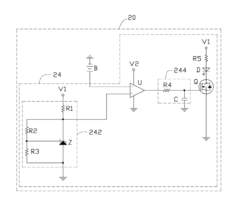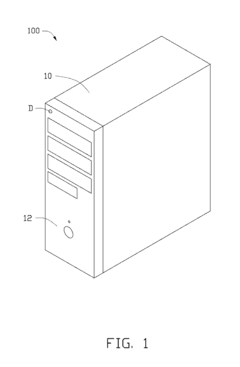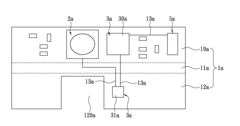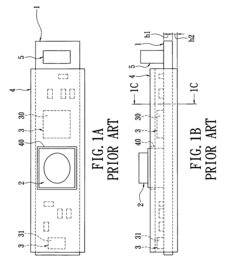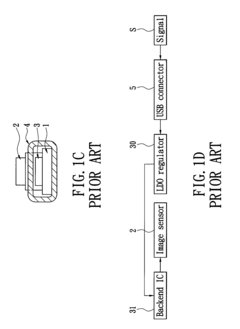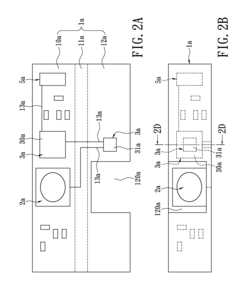Harnessing CMOS Battery Influence for Enhanced User-centric Designs?
JUL 22, 20258 MIN READ
Generate Your Research Report Instantly with AI Agent
Patsnap Eureka helps you evaluate technical feasibility & market potential.
CMOS Battery Evolution
The evolution of CMOS battery technology has been a crucial factor in the advancement of user-centric designs in electronic devices. Initially introduced in the 1980s, CMOS batteries were primarily used to maintain system clock and BIOS settings in personal computers. Over time, their role has expanded significantly, influencing various aspects of device functionality and user experience.
In the early stages, CMOS batteries were simple coin cell batteries with limited capacity and lifespan. As technology progressed, manufacturers began to focus on improving battery longevity and reliability. This led to the development of more efficient lithium-based CMOS batteries in the 1990s, which offered extended life spans and better performance in varying environmental conditions.
The turn of the millennium saw a shift towards miniaturization in electronic devices, prompting the need for smaller, yet more powerful CMOS batteries. This trend resulted in the creation of ultra-thin batteries and the exploration of alternative power sources, such as supercapacitors, for maintaining critical system information.
As mobile devices gained prominence in the 2000s, the role of CMOS batteries expanded beyond traditional computing systems. Smartphones and tablets began incorporating CMOS-like functionality for maintaining system settings and providing backup power for certain features. This evolution led to the development of integrated power management systems that could efficiently handle both primary and backup power sources.
The increasing focus on energy efficiency and sustainability in the 2010s further shaped CMOS battery technology. Manufacturers began exploring eco-friendly materials and production processes, leading to the development of rechargeable CMOS batteries and energy harvesting solutions. These advancements not only extended battery life but also reduced the environmental impact of electronic waste.
Recent years have seen a convergence of CMOS battery technology with emerging fields such as the Internet of Things (IoT) and wearable devices. This has driven innovation in low-power design and energy management techniques, enabling devices to operate for extended periods without battery replacement or recharging.
The ongoing evolution of CMOS battery technology continues to focus on enhancing user experience through improved reliability, longer lifespan, and seamless integration with device functionality. As we move forward, the development of next-generation CMOS batteries is likely to be influenced by advancements in materials science, energy storage technologies, and the growing demand for more sustainable and user-friendly electronic devices.
In the early stages, CMOS batteries were simple coin cell batteries with limited capacity and lifespan. As technology progressed, manufacturers began to focus on improving battery longevity and reliability. This led to the development of more efficient lithium-based CMOS batteries in the 1990s, which offered extended life spans and better performance in varying environmental conditions.
The turn of the millennium saw a shift towards miniaturization in electronic devices, prompting the need for smaller, yet more powerful CMOS batteries. This trend resulted in the creation of ultra-thin batteries and the exploration of alternative power sources, such as supercapacitors, for maintaining critical system information.
As mobile devices gained prominence in the 2000s, the role of CMOS batteries expanded beyond traditional computing systems. Smartphones and tablets began incorporating CMOS-like functionality for maintaining system settings and providing backup power for certain features. This evolution led to the development of integrated power management systems that could efficiently handle both primary and backup power sources.
The increasing focus on energy efficiency and sustainability in the 2010s further shaped CMOS battery technology. Manufacturers began exploring eco-friendly materials and production processes, leading to the development of rechargeable CMOS batteries and energy harvesting solutions. These advancements not only extended battery life but also reduced the environmental impact of electronic waste.
Recent years have seen a convergence of CMOS battery technology with emerging fields such as the Internet of Things (IoT) and wearable devices. This has driven innovation in low-power design and energy management techniques, enabling devices to operate for extended periods without battery replacement or recharging.
The ongoing evolution of CMOS battery technology continues to focus on enhancing user experience through improved reliability, longer lifespan, and seamless integration with device functionality. As we move forward, the development of next-generation CMOS batteries is likely to be influenced by advancements in materials science, energy storage technologies, and the growing demand for more sustainable and user-friendly electronic devices.
User-centric Design Demand
The demand for user-centric designs in CMOS battery-influenced systems has grown significantly in recent years, driven by the increasing complexity of electronic devices and the evolving expectations of consumers. Users now seek devices that not only perform efficiently but also provide seamless, intuitive experiences tailored to their specific needs and preferences.
One of the primary market demands is for extended battery life without compromising device functionality. As CMOS batteries play a crucial role in maintaining system settings and real-time clocks, optimizing their performance directly impacts user satisfaction. Consumers expect devices that can retain settings and time information for extended periods, even when the main power source is depleted or disconnected.
Another key aspect of user-centric design demand is the integration of smart power management features. Users want devices that can intelligently adjust power consumption based on usage patterns, environmental conditions, and individual preferences. This includes adaptive brightness controls, dynamic processor scaling, and context-aware power modes that seamlessly transition between high-performance and energy-saving states.
Reliability and consistency in device behavior are also paramount in user-centric designs. CMOS batteries must ensure that critical system settings and personalized configurations are maintained consistently, even during power interruptions or battery replacements. This reliability directly translates to a more trustworthy and satisfying user experience.
Furthermore, there is a growing demand for devices with enhanced customization options. Users expect to have granular control over power-related settings, allowing them to fine-tune their devices for optimal performance in specific scenarios. This includes the ability to prioritize certain functions or applications in terms of power allocation, ensuring that critical tasks remain operational even under low-power conditions.
Sustainability and environmental considerations are increasingly influencing user preferences. Consumers are showing a preference for devices with longer lifespans and reduced environmental impact. This translates to a demand for CMOS battery solutions that are not only long-lasting but also easily replaceable or rechargeable, minimizing electronic waste and extending the overall lifespan of devices.
Lastly, as the Internet of Things (IoT) continues to expand, users are seeking seamless integration between their various devices. This integration often relies on consistent and reliable power management across multiple platforms, with CMOS batteries playing a crucial role in maintaining system cohesion and data integrity across interconnected devices.
One of the primary market demands is for extended battery life without compromising device functionality. As CMOS batteries play a crucial role in maintaining system settings and real-time clocks, optimizing their performance directly impacts user satisfaction. Consumers expect devices that can retain settings and time information for extended periods, even when the main power source is depleted or disconnected.
Another key aspect of user-centric design demand is the integration of smart power management features. Users want devices that can intelligently adjust power consumption based on usage patterns, environmental conditions, and individual preferences. This includes adaptive brightness controls, dynamic processor scaling, and context-aware power modes that seamlessly transition between high-performance and energy-saving states.
Reliability and consistency in device behavior are also paramount in user-centric designs. CMOS batteries must ensure that critical system settings and personalized configurations are maintained consistently, even during power interruptions or battery replacements. This reliability directly translates to a more trustworthy and satisfying user experience.
Furthermore, there is a growing demand for devices with enhanced customization options. Users expect to have granular control over power-related settings, allowing them to fine-tune their devices for optimal performance in specific scenarios. This includes the ability to prioritize certain functions or applications in terms of power allocation, ensuring that critical tasks remain operational even under low-power conditions.
Sustainability and environmental considerations are increasingly influencing user preferences. Consumers are showing a preference for devices with longer lifespans and reduced environmental impact. This translates to a demand for CMOS battery solutions that are not only long-lasting but also easily replaceable or rechargeable, minimizing electronic waste and extending the overall lifespan of devices.
Lastly, as the Internet of Things (IoT) continues to expand, users are seeking seamless integration between their various devices. This integration often relies on consistent and reliable power management across multiple platforms, with CMOS batteries playing a crucial role in maintaining system cohesion and data integrity across interconnected devices.
CMOS Battery Challenges
CMOS batteries, while essential for maintaining system configurations and real-time clock functions in electronic devices, present several significant challenges in the context of user-centric design. One of the primary issues is the limited lifespan of these batteries, typically ranging from 3 to 10 years. This constraint necessitates periodic replacement, which can be inconvenient for users and potentially disruptive to device functionality.
The physical size of CMOS batteries poses another challenge, particularly as devices trend towards miniaturization. Integrating these batteries into compact designs without compromising other components or features requires careful engineering and often involves trade-offs in device layout and functionality. This size constraint can limit design flexibility and impact the overall user experience.
Environmental concerns also arise from the use of CMOS batteries. Many contain lithium, which can be harmful if not disposed of properly. This raises issues of sustainability and responsible manufacturing, as well as potential regulatory challenges in different markets. Designers must consider end-of-life scenarios and recyclability in their product development process.
Power management is another critical challenge. CMOS batteries must maintain a delicate balance between providing sufficient power to keep critical information intact and avoiding unnecessary drain that could shorten their lifespan. This becomes particularly complex in devices with extended standby periods or those subjected to extreme temperature variations, which can affect battery performance.
The reliability of CMOS batteries in maintaining accurate timekeeping and preserving system settings is crucial. Failures in this regard can lead to system instability, data loss, and poor user experience. Designers must implement robust error detection and recovery mechanisms to mitigate these risks, adding complexity to both hardware and software design.
Compatibility issues arise when considering the integration of CMOS batteries with emerging technologies. As devices incorporate new features and capabilities, the traditional role and implementation of CMOS batteries may need to evolve. This could involve exploring alternative power sources or developing new battery technologies that better align with future device requirements.
Cost considerations also play a significant role in CMOS battery challenges. While these components are relatively inexpensive, their necessity in many devices adds to the overall bill of materials. In competitive markets where price points are critical, even small cost additions can impact product viability. Balancing the need for reliable CMOS functionality with cost-effective design solutions remains an ongoing challenge for manufacturers.
The physical size of CMOS batteries poses another challenge, particularly as devices trend towards miniaturization. Integrating these batteries into compact designs without compromising other components or features requires careful engineering and often involves trade-offs in device layout and functionality. This size constraint can limit design flexibility and impact the overall user experience.
Environmental concerns also arise from the use of CMOS batteries. Many contain lithium, which can be harmful if not disposed of properly. This raises issues of sustainability and responsible manufacturing, as well as potential regulatory challenges in different markets. Designers must consider end-of-life scenarios and recyclability in their product development process.
Power management is another critical challenge. CMOS batteries must maintain a delicate balance between providing sufficient power to keep critical information intact and avoiding unnecessary drain that could shorten their lifespan. This becomes particularly complex in devices with extended standby periods or those subjected to extreme temperature variations, which can affect battery performance.
The reliability of CMOS batteries in maintaining accurate timekeeping and preserving system settings is crucial. Failures in this regard can lead to system instability, data loss, and poor user experience. Designers must implement robust error detection and recovery mechanisms to mitigate these risks, adding complexity to both hardware and software design.
Compatibility issues arise when considering the integration of CMOS batteries with emerging technologies. As devices incorporate new features and capabilities, the traditional role and implementation of CMOS batteries may need to evolve. This could involve exploring alternative power sources or developing new battery technologies that better align with future device requirements.
Cost considerations also play a significant role in CMOS battery challenges. While these components are relatively inexpensive, their necessity in many devices adds to the overall bill of materials. In competitive markets where price points are critical, even small cost additions can impact product viability. Balancing the need for reliable CMOS functionality with cost-effective design solutions remains an ongoing challenge for manufacturers.
Current CMOS Solutions
01 User-centric CMOS battery management systems
These systems focus on optimizing CMOS battery performance and longevity based on user behavior and preferences. They may include adaptive power management, predictive maintenance, and personalized battery life indicators to enhance user experience and device reliability.- User-centric CMOS battery management systems: These systems focus on optimizing CMOS battery performance and longevity based on user behavior and preferences. They may include adaptive power management, predictive maintenance, and personalized battery life indicators to enhance user experience and device reliability.
- CMOS battery monitoring and diagnostics: Advanced monitoring and diagnostic techniques for CMOS batteries, including real-time status tracking, error detection, and predictive analytics. These features help users stay informed about battery health and performance, potentially preventing unexpected failures.
- Energy-efficient CMOS battery designs: Innovative CMOS battery designs that prioritize energy efficiency and extended battery life. These may include low-power modes, intelligent charge distribution, and advanced materials to maximize battery performance while minimizing power consumption.
- User interface for CMOS battery management: Intuitive and user-friendly interfaces for managing CMOS battery settings and information. These interfaces may include customizable dashboards, easy-to-understand battery health indicators, and simplified power management controls tailored to user preferences.
- CMOS battery integration with IoT and smart devices: Integration of CMOS batteries with Internet of Things (IoT) ecosystems and smart devices, enabling remote monitoring, automated updates, and seamless connectivity. This integration enhances overall device functionality and user convenience in managing battery-powered systems.
02 CMOS battery monitoring and diagnostics
Advanced monitoring and diagnostic tools for CMOS batteries that provide real-time status updates, performance analytics, and early warning systems for potential issues. These features enable proactive maintenance and improve overall system reliability.Expand Specific Solutions03 Energy-efficient CMOS battery designs
Innovative CMOS battery designs that prioritize energy efficiency and extended battery life. These may include low-power consumption modes, intelligent charge distribution, and optimized circuit designs to minimize power drain during standby periods.Expand Specific Solutions04 Integration of CMOS batteries with IoT and smart devices
Solutions that seamlessly integrate CMOS batteries with Internet of Things (IoT) ecosystems and smart devices. These designs enable remote monitoring, automated power management, and synchronization with other connected devices to enhance overall system performance and user convenience.Expand Specific Solutions05 Environmental and user safety considerations in CMOS battery design
CMOS battery designs that prioritize environmental sustainability and user safety. These may include the use of eco-friendly materials, improved thermal management, and fail-safe mechanisms to prevent overheating or leakage, ensuring a safer and more environmentally responsible product.Expand Specific Solutions
Key CMOS Battery Players
The competitive landscape for "Harnessing CMOS Battery Influence for Enhanced User-centric Designs" is in its early development stage, with a growing market potential as consumer electronics and IoT devices proliferate. The technology's maturity is still evolving, with key players like Intel, Apple, and Samsung SDI leading research and development efforts. Companies such as EVE Energy and Contemporary Amperex Technology are also making strides in battery technology, potentially influencing CMOS battery applications. The market size is expected to expand as the technology finds applications in various sectors, including mobile devices, wearables, and smart home systems.
Intel Corp.
Technical Solution: Intel has developed advanced power management techniques for CMOS batteries in their chipsets and processors. They utilize dynamic voltage and frequency scaling (DVFS) to optimize power consumption based on workload demands[1]. Intel's latest processors incorporate machine learning algorithms to predict user behavior and adjust power states accordingly, extending CMOS battery life[3]. They have also implemented a "Time Aware Power Management" feature that learns from historical usage patterns to optimize power delivery and battery performance over time[5].
Strengths: Industry-leading expertise in processor design and power management. Extensive R&D resources. Weaknesses: Primarily focused on x86 architecture, which may limit applicability in some mobile devices.
Apple, Inc.
Technical Solution: Apple has made significant strides in CMOS battery optimization for user-centric designs. Their custom-designed A-series and M-series chips incorporate advanced power gating techniques to minimize idle power consumption[2]. Apple's Power Nap feature allows devices to perform background tasks while in low-power sleep mode, leveraging CMOS battery efficiently[4]. They have also implemented an Intelligent Tracking Prevention system that reduces background activity of web content, further preserving battery life[6]. Apple's latest devices use machine learning to understand user habits and optimize charging patterns to reduce battery aging[8].
Strengths: Vertical integration allows for tight hardware-software optimization. Strong focus on user experience. Weaknesses: Closed ecosystem may limit broader industry adoption of their innovations.
CMOS Battery Innovations
Host computer
PatentInactiveUS20120043993A1
Innovation
- Incorporating a voltage detection circuit within the host computer that includes a comparator, electronic switch, alarm unit, reference voltage generating circuit, and delay circuit to detect and alert the user when the battery voltage falls below a certain threshold, using a light emitting diode as an alarm unit.
Image-sensing module for reducing overall thickness thereof and preventing EMI
PatentActiveUS8054639B2
Innovation
- The use of a flexible substrate with a first and second PCB, where the image sensor is exposed through a first opening, allowing the electronic elements to be disposed between the PCBs, reducing thickness and preventing electromagnetic interference by forming metal shields and using insulative adhesive layers to manage signal transmission efficiently.
Energy Efficiency Metrics
Energy efficiency metrics play a crucial role in evaluating the performance and sustainability of CMOS battery-influenced designs. These metrics provide quantitative measures to assess the effectiveness of energy utilization and conservation in user-centric systems. One of the primary metrics is power consumption, which measures the rate at which energy is consumed by the device. This metric is typically expressed in watts (W) and can be further broken down into active power and standby power.
Another important metric is energy density, which represents the amount of energy stored per unit volume or mass of the battery. This metric is particularly relevant for portable devices where space and weight constraints are significant factors. Energy density is often measured in watt-hours per liter (Wh/L) or watt-hours per kilogram (Wh/kg).
Battery life is a critical metric that directly impacts user experience. It is typically measured in hours and represents the duration a device can operate on a single charge. This metric is influenced by factors such as battery capacity, power management techniques, and usage patterns. Closely related to battery life is the charge-discharge cycle efficiency, which measures the ratio of energy extracted from the battery during discharge to the energy required to recharge it.
The power efficiency ratio (PER) is another valuable metric that quantifies the overall efficiency of the system. It is calculated as the ratio of useful output power to the total input power. A higher PER indicates better energy utilization and reduced waste. Additionally, the energy harvesting efficiency metric becomes relevant when considering systems that incorporate energy harvesting techniques to supplement or recharge the CMOS battery.
Thermal efficiency is an often-overlooked but crucial metric in CMOS battery-influenced designs. It measures the system's ability to convert energy into useful work while minimizing heat generation. This metric is particularly important for maintaining device performance and prolonging battery life, as excessive heat can lead to reduced efficiency and accelerated battery degradation.
Lastly, the energy cost per operation metric provides insights into the energy consumption of specific tasks or functions within the system. This granular approach allows designers to identify and optimize energy-intensive operations, leading to more efficient overall system design. By carefully considering and optimizing these energy efficiency metrics, designers can create CMOS battery-influenced systems that offer enhanced user experiences while minimizing energy consumption and environmental impact.
Another important metric is energy density, which represents the amount of energy stored per unit volume or mass of the battery. This metric is particularly relevant for portable devices where space and weight constraints are significant factors. Energy density is often measured in watt-hours per liter (Wh/L) or watt-hours per kilogram (Wh/kg).
Battery life is a critical metric that directly impacts user experience. It is typically measured in hours and represents the duration a device can operate on a single charge. This metric is influenced by factors such as battery capacity, power management techniques, and usage patterns. Closely related to battery life is the charge-discharge cycle efficiency, which measures the ratio of energy extracted from the battery during discharge to the energy required to recharge it.
The power efficiency ratio (PER) is another valuable metric that quantifies the overall efficiency of the system. It is calculated as the ratio of useful output power to the total input power. A higher PER indicates better energy utilization and reduced waste. Additionally, the energy harvesting efficiency metric becomes relevant when considering systems that incorporate energy harvesting techniques to supplement or recharge the CMOS battery.
Thermal efficiency is an often-overlooked but crucial metric in CMOS battery-influenced designs. It measures the system's ability to convert energy into useful work while minimizing heat generation. This metric is particularly important for maintaining device performance and prolonging battery life, as excessive heat can lead to reduced efficiency and accelerated battery degradation.
Lastly, the energy cost per operation metric provides insights into the energy consumption of specific tasks or functions within the system. This granular approach allows designers to identify and optimize energy-intensive operations, leading to more efficient overall system design. By carefully considering and optimizing these energy efficiency metrics, designers can create CMOS battery-influenced systems that offer enhanced user experiences while minimizing energy consumption and environmental impact.
CMOS Battery Recycling
CMOS battery recycling is a critical aspect of sustainable electronics management, addressing both environmental concerns and resource conservation. As electronic devices become increasingly prevalent, the proper disposal and recycling of CMOS batteries have gained significant attention. These small, coin-shaped batteries, typically made of lithium, play a crucial role in maintaining system settings and real-time clocks in various electronic devices.
The recycling process for CMOS batteries involves several key steps. Initially, the batteries are collected from discarded electronic devices or dedicated collection points. They are then sorted based on their chemical composition and physical characteristics. The next stage involves disassembling the batteries to separate their components, including the lithium, steel casing, and other metals.
One of the primary challenges in CMOS battery recycling is the safe handling of lithium, which is highly reactive. Specialized facilities employ controlled environments to prevent potential fires or explosions during the recycling process. Advanced technologies, such as hydrometallurgical processes, are utilized to extract and recover valuable materials from the batteries.
The recovered materials find applications in various industries. Lithium, for instance, can be repurposed for new battery production or used in other industrial processes. Steel and other metals are recycled into new products, reducing the demand for virgin materials and minimizing environmental impact.
Efforts to improve CMOS battery recycling efficiency are ongoing. Research focuses on developing more effective separation techniques and exploring new recycling methodologies. Additionally, there is a growing emphasis on designing batteries with recycling in mind, incorporating easily separable components and using materials that are more conducive to recycling processes.
The regulatory landscape surrounding CMOS battery recycling continues to evolve. Many countries have implemented strict guidelines for the disposal and recycling of electronic waste, including CMOS batteries. These regulations aim to prevent environmental contamination and promote responsible resource management. Manufacturers are increasingly being held accountable for the entire lifecycle of their products, including end-of-life disposal and recycling.
As the demand for electronic devices grows, so does the importance of efficient CMOS battery recycling. This process not only helps in reducing electronic waste but also contributes to the circular economy by recovering valuable resources. Future advancements in recycling technologies and increased awareness about proper disposal methods are expected to further enhance the sustainability of CMOS battery usage in electronic devices.
The recycling process for CMOS batteries involves several key steps. Initially, the batteries are collected from discarded electronic devices or dedicated collection points. They are then sorted based on their chemical composition and physical characteristics. The next stage involves disassembling the batteries to separate their components, including the lithium, steel casing, and other metals.
One of the primary challenges in CMOS battery recycling is the safe handling of lithium, which is highly reactive. Specialized facilities employ controlled environments to prevent potential fires or explosions during the recycling process. Advanced technologies, such as hydrometallurgical processes, are utilized to extract and recover valuable materials from the batteries.
The recovered materials find applications in various industries. Lithium, for instance, can be repurposed for new battery production or used in other industrial processes. Steel and other metals are recycled into new products, reducing the demand for virgin materials and minimizing environmental impact.
Efforts to improve CMOS battery recycling efficiency are ongoing. Research focuses on developing more effective separation techniques and exploring new recycling methodologies. Additionally, there is a growing emphasis on designing batteries with recycling in mind, incorporating easily separable components and using materials that are more conducive to recycling processes.
The regulatory landscape surrounding CMOS battery recycling continues to evolve. Many countries have implemented strict guidelines for the disposal and recycling of electronic waste, including CMOS batteries. These regulations aim to prevent environmental contamination and promote responsible resource management. Manufacturers are increasingly being held accountable for the entire lifecycle of their products, including end-of-life disposal and recycling.
As the demand for electronic devices grows, so does the importance of efficient CMOS battery recycling. This process not only helps in reducing electronic waste but also contributes to the circular economy by recovering valuable resources. Future advancements in recycling technologies and increased awareness about proper disposal methods are expected to further enhance the sustainability of CMOS battery usage in electronic devices.
Unlock deeper insights with Patsnap Eureka Quick Research — get a full tech report to explore trends and direct your research. Try now!
Generate Your Research Report Instantly with AI Agent
Supercharge your innovation with Patsnap Eureka AI Agent Platform!
